Easy Experiments Kids Can Present in Class
Do you have a budding scientist living in the house with you? You're probably looking for ways to foster their love of science and all things STEM. Luckily, even simple science experiments done at home can be super educational and fun for kids of all ages.
We scoured the internet and practiced these experiments with our own young kids to test them out and make sure they were good ones.
Each of these easy science experiments will take about 30 minutes to complete from start to finish, and they each use simple ingredients from around the house.
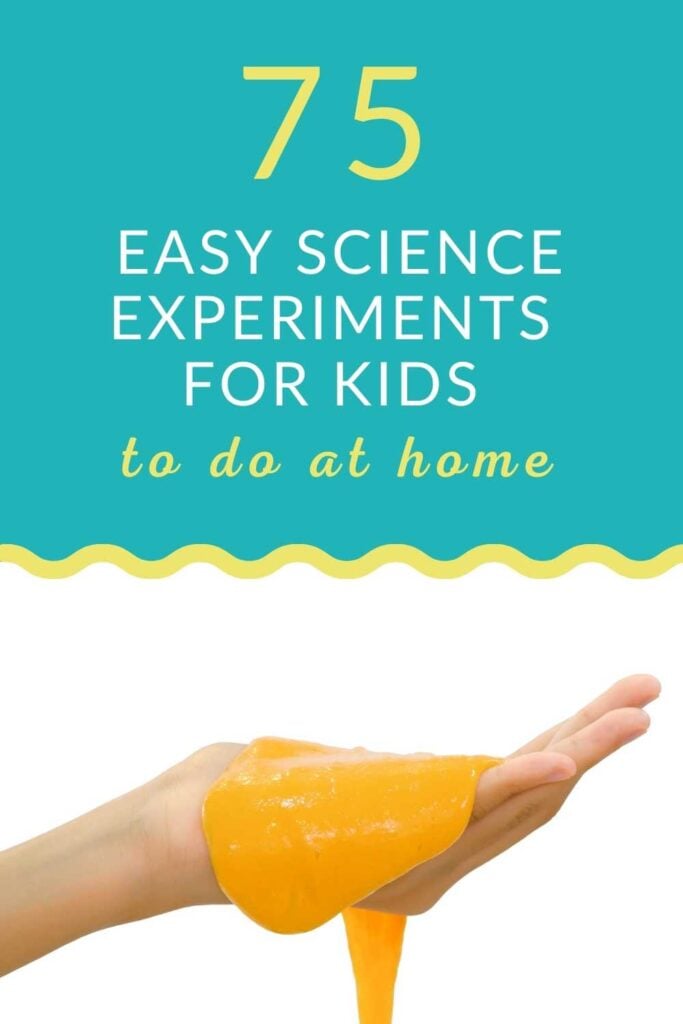
These stem challenges use household items like food coloring, dish soap, paper towels, ice cubes, rubber bands, white vinegar, vegetable oil, and baking soda. They teach simple science concepts that your kids will use in school for years to come.
Kids of all ages will love these cool science experiments and science activities that you can do together on the weekend or after school. It's also a great way to learn about the scientific method that they'll use throughout their schooling and perhaps their whole life!
And, you never know. One simple experiment might be the light bulb moment that inspires them to be a scientist for life.
At the very least, you'll probably inspire some really cool science fair projects.
Without further ado, here is our massive list of fun science experiments. Let's introduce your child to the magical world of science!
1. Homemade Lava Lamp
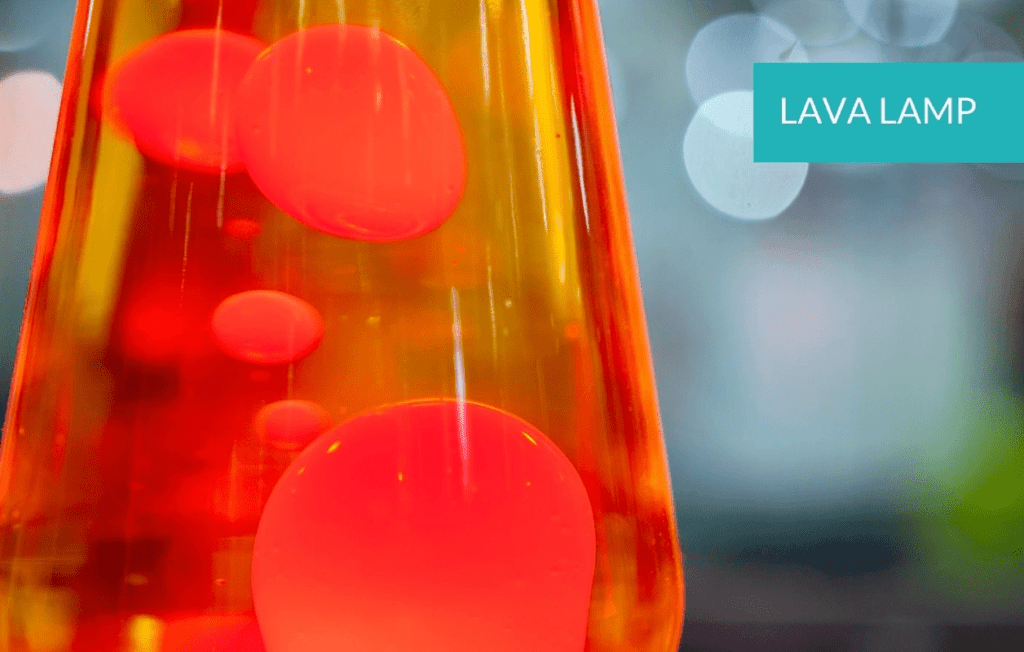
Overview:
This simple experiment is especially a hit with kids ages 4-12 (and beyond!), and it will take their favorite adults back a few decades, too! This easy science activity teaches kids about density.
What You Need:
A clean plastic bottle (or several plastic bottles)
Water
Vegetable Oil
Fizzing tablets (like an Alka-Seltzer tablet)
Food Coloring
Steps:
Fill the bottle up with water about 1/4th full. Pour the vegetable oil into the bottle until is almost full. Use a funnel if you have one. Wait a few moments and watch as the oil and water separates.
Then, add a few drops of your favorite color food coloring. Watch the color make its way through the oil.
The next step is to break your fizzy tablet in half and drop part of it into the bottle. Watch the bubble blobs form.
Finally, if you have a flashlight, turn off the lights and drop in another half tablet. Shine the flashlight through the lava lamp while the blobs are bubbling!
What's Happening:
The oil floats on top of the water because it is less dense (lighter) than water. The food coloring has the same density as the water so it sinks through the oil and mixes with the water. As the tablet dissolves it creates a gas called carbon dioxide.
Gas is lighter than water so it floats to the top, bringing some color with it from the food coloring. When the air releases from the colored water blob, the water gets heavy again and sinks.
2. Exploring Surface Tension (With Black Pepper!)
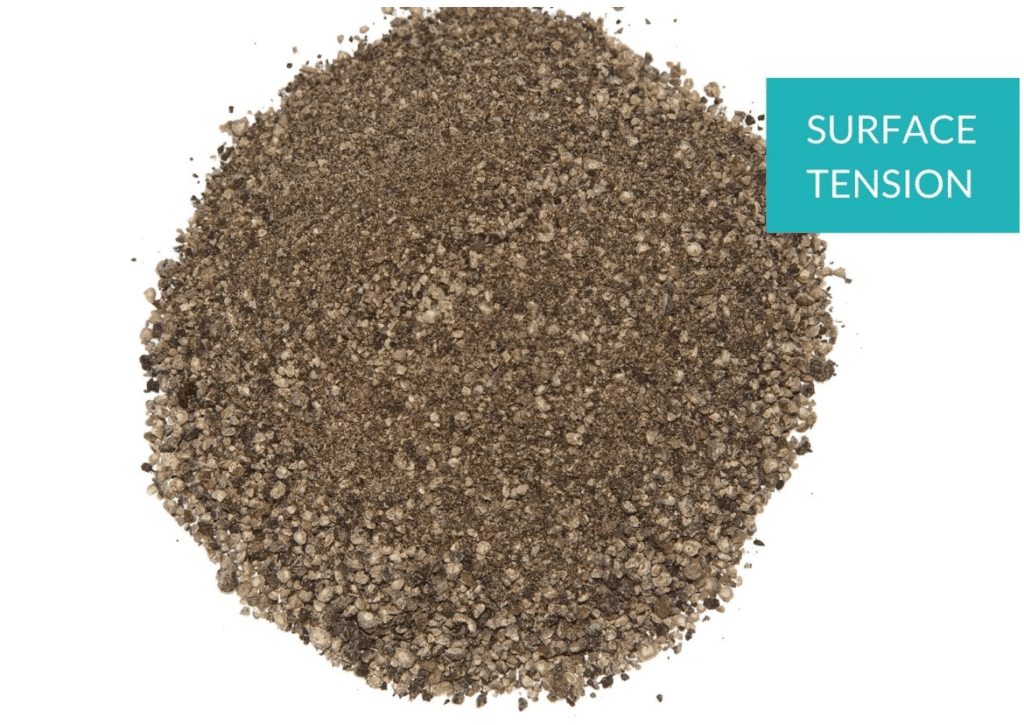
Overview:
Surface tension is a foundational scientific principle that even young kids can begin to learn about. This simple experience using water, soap, and black pepper will get kids of all ages exploring this useful concept.
What You Need:
black pepper
a plate or bowl
water
liquid soap
Steps:
First, fill the plate with a thin layer of water, less than an inch deep is plenty.
Then, sprinkle the pepper on to the water, covering a much of the water surface as possible. The more pepper, the more fun.
Finally, dip your finger into the liquid soap. Touch the pepper and see what happens!
What's Happening:
The soap is breaking the surface tension of the water! Surface tension exists in water because the water molecules (the littles pieces of the water) like to stick together.
Water has high surface tension, which mans the molecules like the pull towards each other and stick together very strongly.
But, when soap is added to it, it break the surface tension. The molecules close to your fingers are pulled away by molecules that are farther away from your finger.
3. Elephant Toothpaste
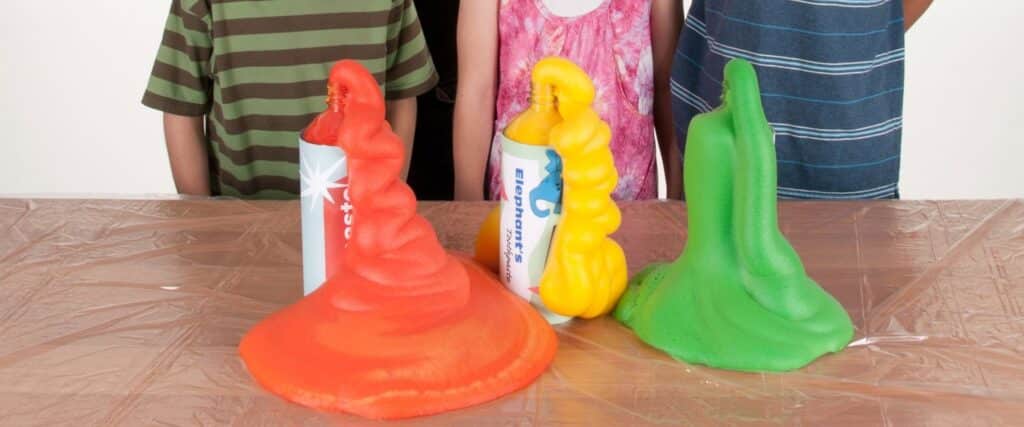
Overview:
Have you heard of the elephant toothpaste experiment yet? It's a blast! You will need an adult for this experiment. Kids of all ages will love learning about catalysts and exothermic reactions in this simple fun science activity.
What You Need:
16-oz plastic soda bottle
1/2 cup 20-volume of 6% solution hydrogen peroxide liquid
1 Tablespoon dry yeast
3 Tablespoons of warm water
Liquid dish soap
Food coloring
Small cup
Safety goggles
Steps:
First and foremost, put on your safety goggles or protective eyewear. Hydrogen peroxide can irritate skin and eyes. As a safety precaution, an adult should always be the one to carefully pour the hydrogen peroxide into the bottle.
The next step is to add 8 drops of your favorite color food coloring into the bottle.
Then, add 1 tablespoon of liquid dish soap and swish the bottle around the mix the ingredients together.
In a separate cup, mix the warm water and yeast together for 30 seconds.
Finally, pour the yeast water mixture into the bottle and watch the foam form!
What's Happening:
Each tiny bubble in the foal is filled with oxygen. The yeast was a catalyst (it helper) to remove the oxygen from the hydrogen peroxide. Because it happened so fast, it created lots of bubbles.
The bottle got hot because this reaction is an exothermic reaction that created heat. The foam is made up simple of water, soap, and oxygen, so you can safely pour it down the drain. Voila!
4. Homemade Slime
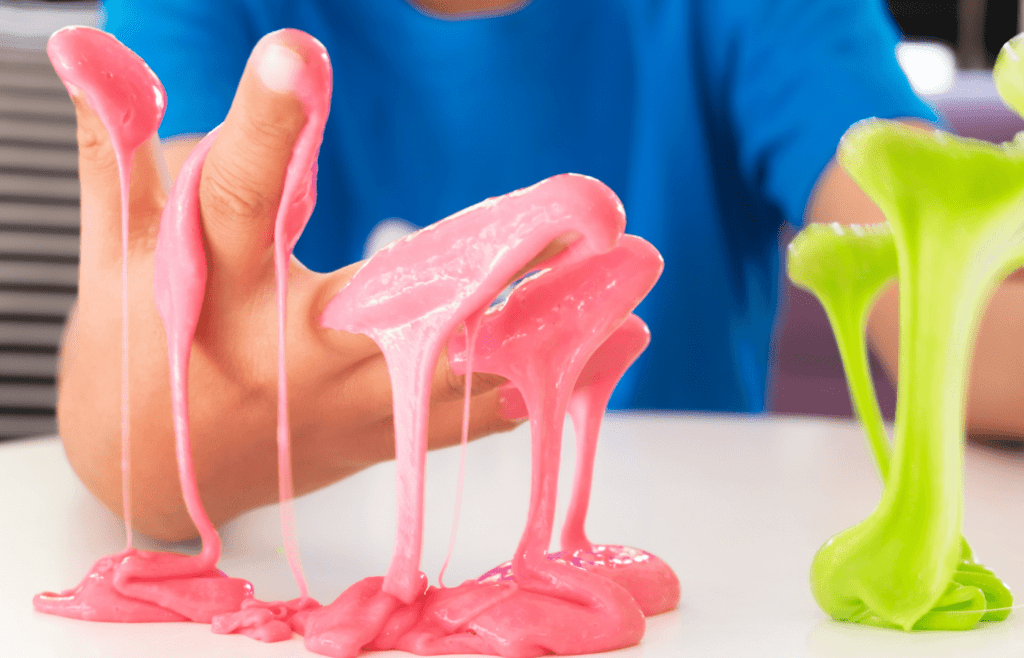
Overview:
What kid doesn't love slime? This is one of our favorite science experiments because it's a sure kid-pleaser! In this basic recipe, you can make some of your own right in your kitchen, and have fun squeezing it with your bare hands all day long. Slime has quickly become one of those classic science experiments that every family should try at least once!
Materials:
Water
-White school glue
-food coloring
-borax
-two bowls
Steps:
First, mix 1/4 cup of water and 1/4 cup of white school glue in a bowl. (Double the recipe if you'd like more.)
Next, if you want your slime to be colorful, add a few drop of food coloring to the mixture.
Then, mix 1/2 tablespoon of borax and 1/2 a cup of water and stir it around until the borax dissolves. I
Finally, add the borax solution to the glue mixture and mix them together. Voila!
Variations:
For glow in the dark slime, use glow-in-the-dark glue. For glittery slime, add glitter!
Don't have borax lying around the house? Order some from Amazon at a good price.
5. Light Refraction Magic
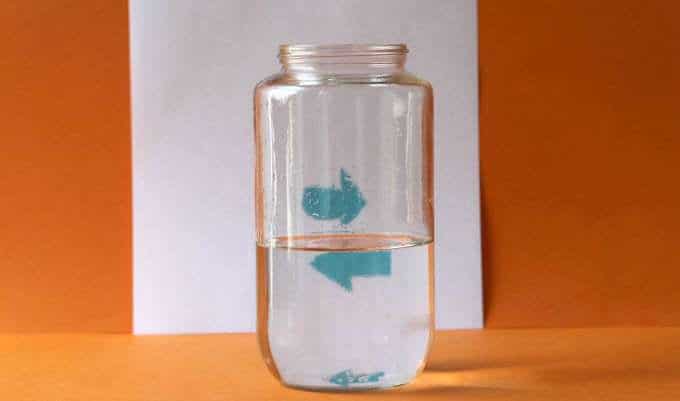
Overview:
This super simple science experiment is really more of a magic trick, and it will teach your kids all about light refraction.
What You Need:
Piece of Paper
Marker
Glass
Water
Steps:
Get a sheet of paper and draw two big arrow on it, one near the top, and one new the bottom. Make the arrow point in the same direction.
Next, fill a glass with water. Slowly lower the piece of paper behind the glass of water. Look through the glass of water, and watch in amazement!
What's Happening:
Refraction is the bending of light and it happens when light travels from one medium to another, like from air to water, or water to air. In this experiment, the light traveling from the paper through the air, then through the glass and into the water, and finally out of the glass and into the air one more before ever reaching our eyes.
Light travels the fastest through air, and a little more slowly through water, and even MORE slowly through glass. That means that the light bends when it travels through the glass cup into the water, and then it bends again when it travels out of the glass cup into the air.
The light paths actually cross and the image appears to be flipped.
6. Dancing Raisins
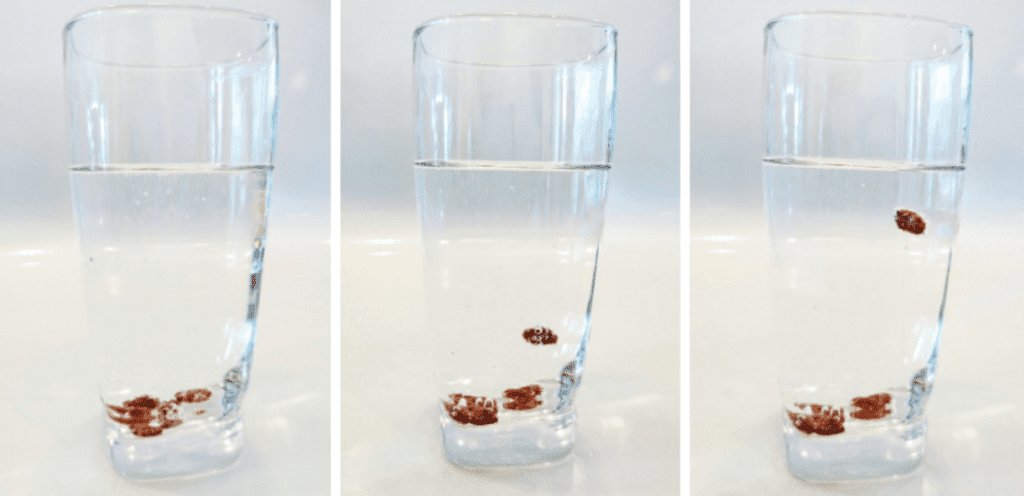
Overview:
Home science experiments don't have to be complicated. In this very easy science experiment that's perfect for young kids, you'll need a few simple ingredients that you probably already have in your household: clear soda, a glass of water, and a handful of raisins. With these simple ingredients, you'll produce chemical reactions that your kids can watch in real time!
What You'll Need:
Clear Soda
A clear glass of water
Handful of raisins
Steps:
First, you fill one glass with clear soda, and another glass with plain water or a different liquid that does not have gas bubbles. Then, place the raisins in each glass, and watch how they dance in the glass with clear soda.
The gas bubbles from the soda carry the raisins upwards. When they pop, the raisin sinks again.
What's happening?
Once the carbon dioxide bubbles reach the surface of the soda they pop and the gas is released into the air. This makes the raisin lose buoyancy and fall back down to the bottom of the glass. This is why the raising acts differently in different liquids.
7. Sink or Float?
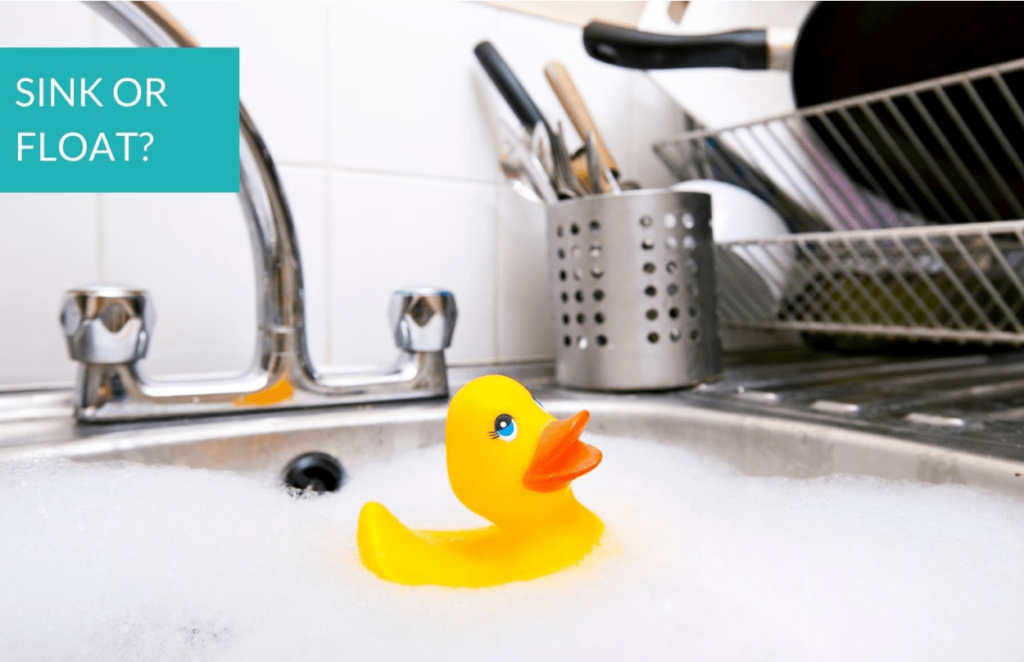
Overview:
Kids of all ages but especially young children will love this easy science experiment that builds a foundation to understanding density. This is one of our favorite science activities for the little ones!
What You'll Need:
Two glasses of water
Small items from around the house
A piece of paper and a pen
Steps:
First, you fill two large clear containers with water. Then, ask your kids to gather small items from around the house in order to see if they'll sink or float.
Before you test them, have you kids write a list of the objects on a piece of paper and ask them to predict if they'll sink or float.
Now, test out each item, and compare it with their hypothesis! This is a great way to teach them the scientific method.
Finally, you can ask them, now that they have seen some of the objects sinking and floating, is there anything else they'd like to test?
8. Shiny Pennies
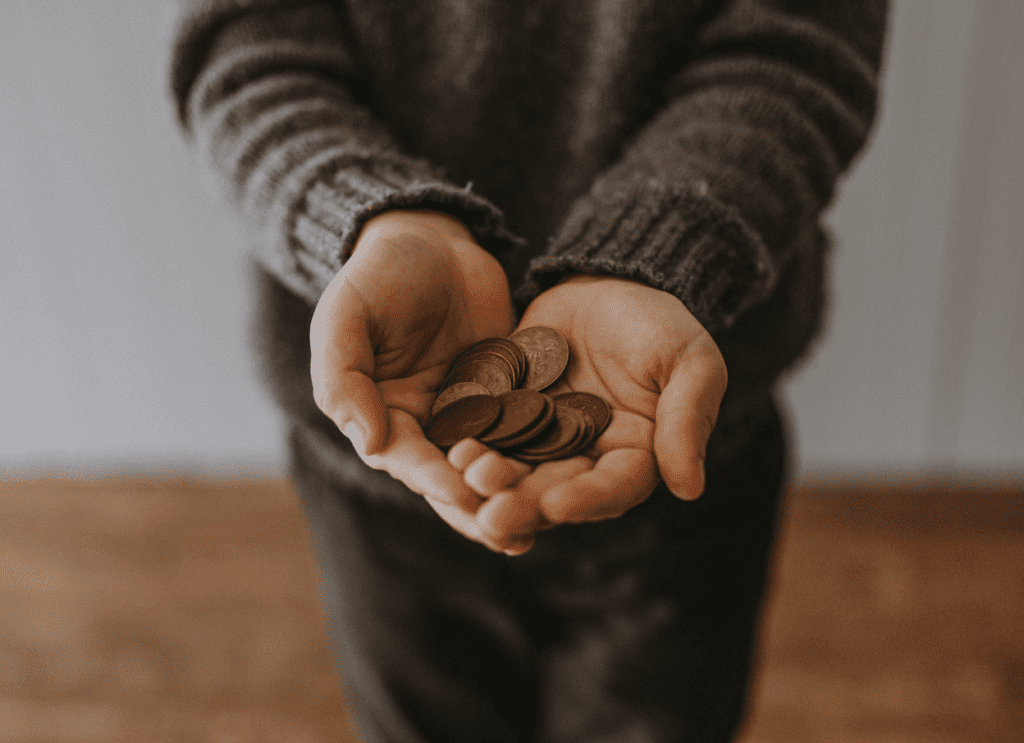
Overview:
You definitely have some dirty pennies lying around your house, so let's put them to good use in a simple and fun science experiment that even young kids can enjoy. Pennies are copper, and they are often in circulation for years (yuck!), so they often appear very tarnished. In this experience, you're going to see if soap or vinegar (or other liquids) do a better job at cleaning the exterior of the dirty copper penny.
What You'll Need
dirty pennies
2 paper cups
Vinegar
Dish soap
Paper towel
Other liquids from around the house (ketchup, soda, etc.)
Steps:
First, make some guesses about which liquid will make the penny the shiniest.
Then, put each penny in a paper cup. In one up, pour in enough vinegar to totally cover the dirty penny. In the other cup, pour in enough dish soap to totally cover the dirty penny.
Wait about ten minutes. A
fter ten minutes, take the pennies out, rinse them in water, and rub them with a paper tower. Now compare the pennies and see how clean they got!
Lastly, try it with other liquids from around the house.
What's Happening:
Pennies get dull over time because the copper on the exterior reacts with oxygen from the air. The copper and oxygen form copper oxides that make the penny dull and dark.
The acetic acide in the vinegar dissolves these chemicals and leaves the penny looking new and shiny.
Dish soap is great for cleaning lots of things, but it can't dissolve copper oxides.
9. Rainbow Celery (Capillary Action!)
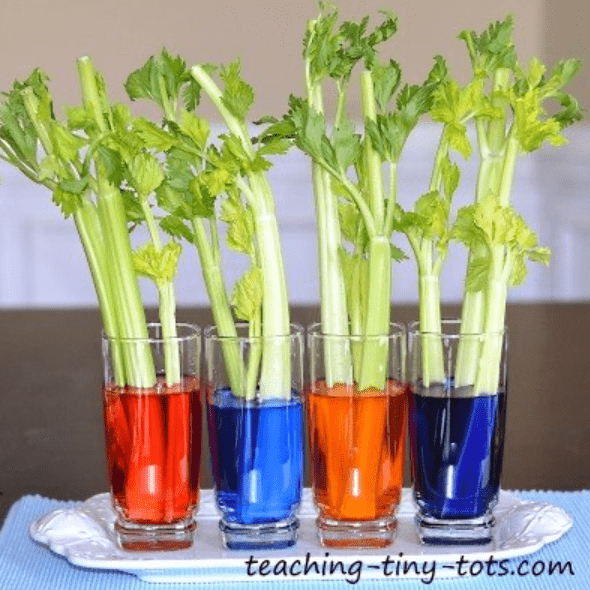
Overview:
Got some celery in the fridge? Then you can begin to learn about capillary action with a simple and colorful color-changing celery experiment. It's a really cool project that your kids are sure to remember for years to come!
What you need:
Celery
Glasses of water
Food coloring
Steps:
Find a sunny spot, and fill the glasses up halfway with water.
Then drop different colors of food coloring into each of the glasses. (It's fun to put the colors in the order of a rainbow!)
Next, cut stalks of celery and put them in the glasses of water.
Let the celery sit for awhile. It will take a few hours at least, but pretty soon you'll notice the leaves changing colors. You can also do this experiment with a light-colored flower.
What's Happening:
This easy experiment will demonstrate to your child how the small "vessels" in celery stalks can carry the water (and rainbow colors!) to the leaves of the celery, mimicking the way blood travels through the body.
10. Mixing Impossible
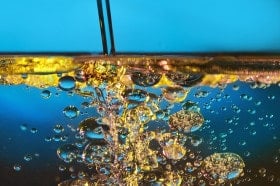
Overview:
This super easy experiment involves mixing equal parts oil and water and adding a drop of food coloring to see what happens. Kids will love watching the food coloring make it through the oil. You will love how easy it is to set up and clean up!
What You Need:
Several drinking glasses
water
vegetable oil
liquid food coloring
a toothpick (if you have it
Steps:
First, ask yourselves what you think will happen when you mix oil and water together.
Then, pour about ½ cup of oil into a drinking glass
Next, pour the same amount of water into the same glass
Watch how the two separate from each other!
Ask what they think will happen when you put one drop of water-based food coloring into the oil
Have the child put a drop in and observe (if the drop needs encouragement to move downward, use a toothpick)
Ask again which is denser, the water-based drop or oil (the water-based drop sinks, showing it's more dense than oil)
What's Happening:
Imagine two objects that are the same size but different weights. The one that weighs more has more matter packed into it. It is denser. A good way to tell if something is more or less dense than water is to put it in water. If it sinks, it's denser, if it floats, it's less dense. The oil floats, showing it's less dense than water.
11. Exploring Colors With Baking Soda / Vinegar
Overview:
In this science activity for kids of all ages, your little scientists will create a chemical reaction, explore color mixing, AND create colorful artwork. Triple win!
What You Need:
Tray (A baking sheet will do)
Baking soda
White vinegar
Ice Cube Trays or other containers to hold the colored vinegar
Pipettes or eye droppers
Liquid watercolors or food coloring
Steps:
1. Give each child a tray.
2. Fill the tray with a heaping amount of baking soda.
3. Fill each ice cube tray (or other container) with vinegar. Add liquid watercolors to the vinegar so your child has a variety of colors to use.
4. Use a pipette or eye dropper to place a few drops of the colored vinegar onto the tray of baking soda. Watch what happens!
5. Continue exploring with other colors.
One reader said this kept her kids busy for an hour! Priceless.
12. Tie-Dye
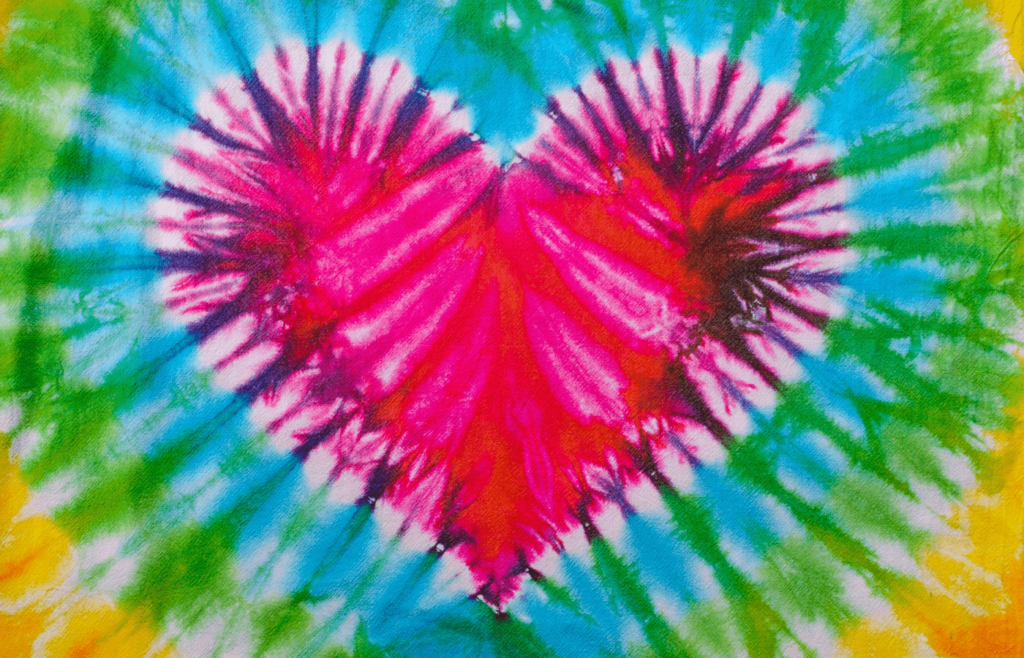
Who would have thought that everyone's favorite t-shirt pattern is actually a great science lesson, too? All you need is an old white t-shirt or pillowcase, some rubber bands, buckets, and dye.
Next, roll up your t-shirt and tie each rubber band strategically to create a design.
Then, begin dipping the t-shirt in the different colored dyes.
As your child dyes the shirt, they'll be observing water solubility and absorption in real time. The dyes are fiber-reactive, which means that a chemical reaction takes places between the dye molecules and fabric molecules so that they actually become one. The dye bonds with the fabric and actually becomes a part of it.
To learn how to wash and care for your tie-dye shirt, click here.
13. Mini Volcanos
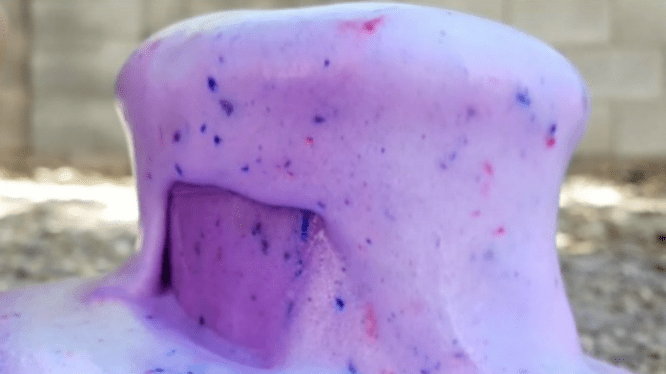
Overview:
This super easy baking soda and vinegar volcano eruption is a real crowd-pleaser for kids of all ages, and your kids will be begging to do it over and over again!
All you need is a few very basic household ingredients, and your colorful volcano will be erupting in no time. It only takes about three minutes to prep.
If you want this to be a no mess science experiment, plan to do it outside on the dirt or on rocks.
Ingredients
Plastic cup
Water
3-4 Tbs of baking soda at least
1 tsp of dish soap
Food coloring (or washable paint if you want to avoid staining)
1 cup (8 oz) of Vinegar
Steps:
First, combine your base ingredients by putting the water inside of the plastic cup and filling it about 2/3 full.
Then add the baking soda, dish soap, and a little bit of food coloring or washable paint. Using washable paint instead of food coloring will help you avoid staining.
Stir the ingredients together.
Then, pour in the vinegar until it starts foaming and pouring out of the cup.
Repeat as necessary with more colors. Your kids will definitely be asking for more.
What's Happening:
The "lava" bubbles that erupt are filled with carbon dioxide. The carbon dioxide is a gas that forms when an acid — the vinegar — reacts with a base — the baking soda.
14. Static Electricity Hair
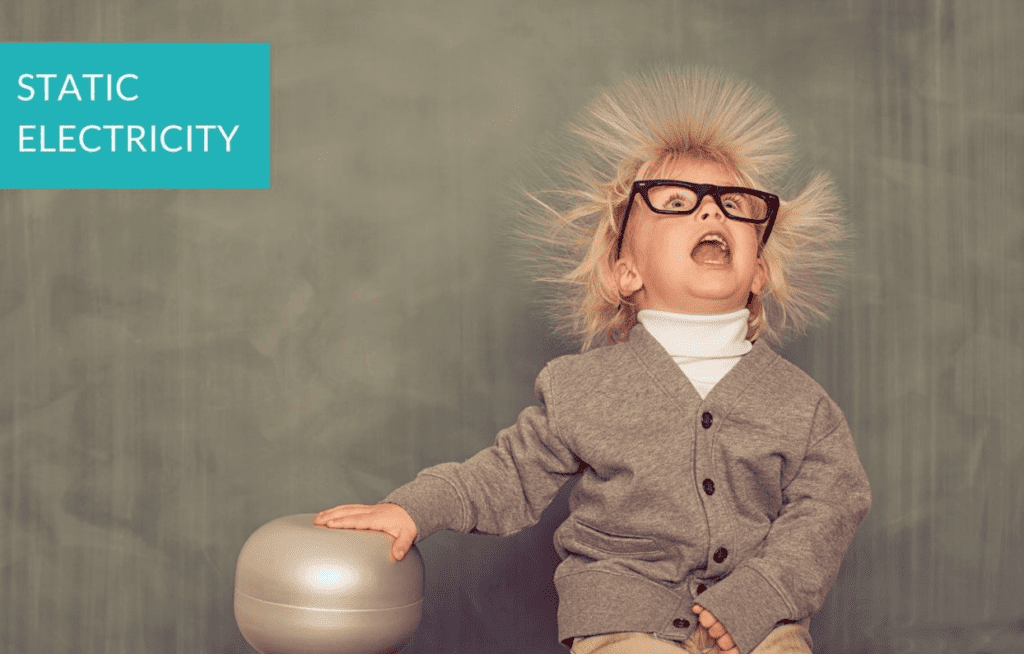
Overview:
Want to provide your kids with (literally) hair-raising good time? It's super simple to teach your kids about static electricity with this easy, no-mess science activity.
What You need:
an inflated balloon
a piece of cloth
Steps:
Rub the surface of the balloon with the cloth for at least40 seconds. Then, hold the balloon a short distance above your head and watch your hair stick to it!
What's Happening:
The balloon gains electrons from the cloth and becomes negatively-charged when you rub it together. Then, when the balloon touches you hair, it attracts your hair, which is positively charged.
15. What's That Mystery Smell?
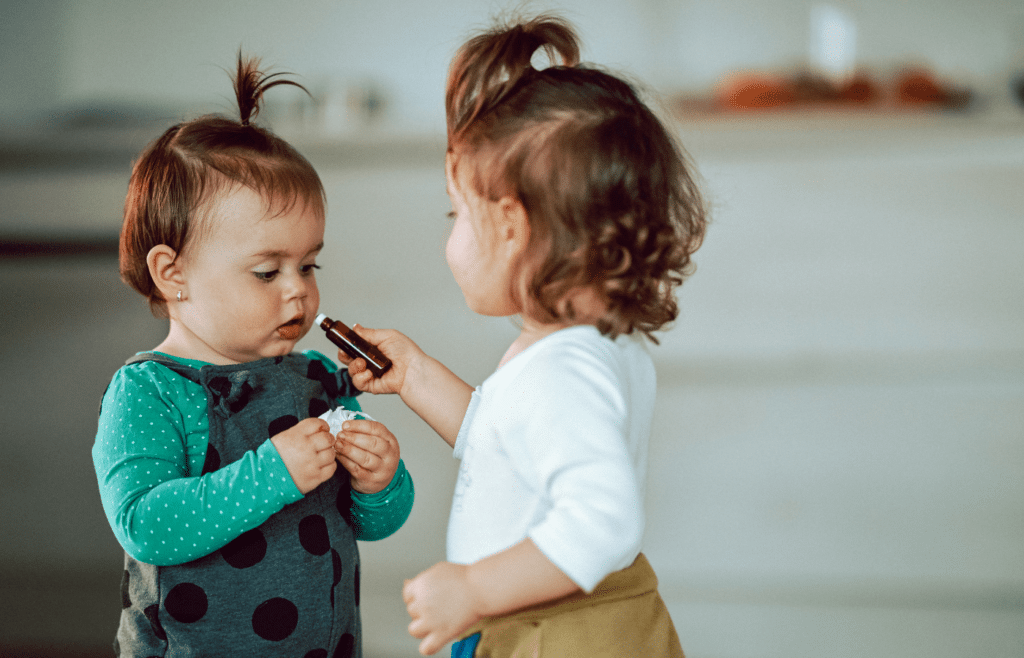
Overview:
Kids of all ages can recognize a lot of different smells, and the process of using your senses is very important to the scientific method.
In this experiment, you'll use your senses to see how many different smells you can recognize.
What You Need:
A grown-up or friend to help
A blindfold
Small, lidded containers that you can't see through
Smelly things from around the house such as bananas, an orange peel, lemons, a cotton ball soaked in perfume, chopped onion, coffee (or a used coffee filter!), rose or flower petals, pencil shavings, vanilla, vinegar, ginger, etc.
Steps:
First, have a grown up put the smelly items in the containers.
Then, write a number on the side of each container.
The next step is to put your blindfold on and have them help you smell each object.
Write down what you think is inside of each container.
Finally, check your guesses! How many did you guess correctly?
16. Water Cycle In A Bag
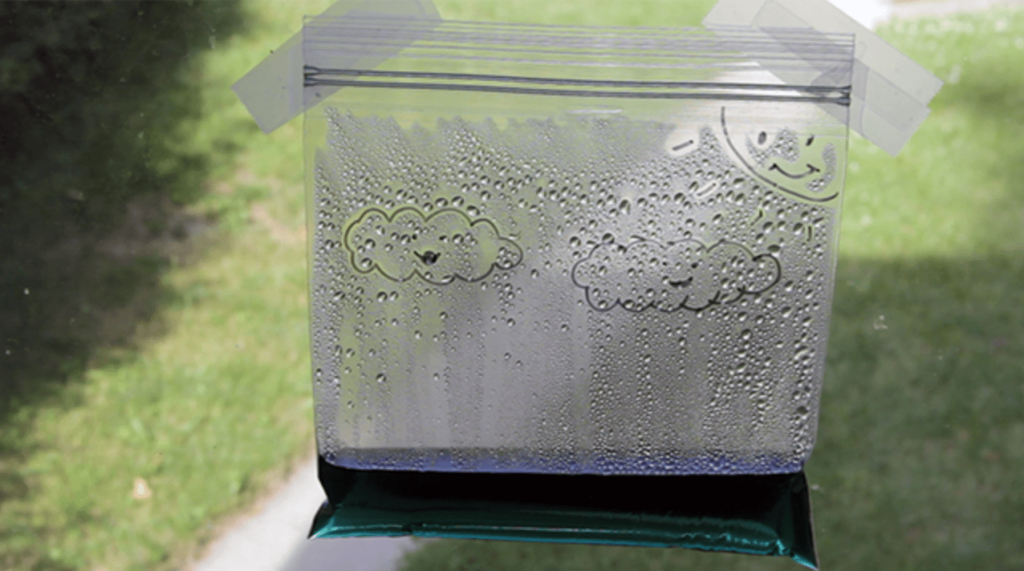
Overview:
This is one of the best science experiments to teach your kids about the water cycle, and it's so easy to do!
Materials:
-Zip lock bag
-permanent marker
-water
-blue food coloring
-clear tape
Steps:
First, use a permanent market to draw a sky on the upper half of your ziplock bag. Include clouds and the sun.
Next, fill a cup with water and add a few drops of blue food coloring. This will help the water be more visible to your kids. Mix it up until it's a striking blue color.
Then, pour the water into the bag and zip it tight so no water escapes.
Now, hang your bag up on a window that gets a lot of sunshine. Affix it with tape on the corner to ensure it doesn't fall.
In a couple of hours, you can check on your bag, and then check again in about a day. You will eventually start to see drops of water sticking to the side of the bag. Some will be in the "clouds" and other drops will be coming down like rain.
What's Happening?
The sun is heating up the water in the bag, which turns the water into a gaseous state in a process called evaporation. This happens in our atmosphere, too. Because the water is in a bag and has nowhere to go, it sticks to the sides of the bag, turning back into a liquid. This is called condensation. This experiment demonstrates the power of the sun to transform water into different states.
17. What's That Mystery Object?
Overview:
The process of using your sense of touch is very important to the scientific method. In this experiment, you'll use your sense of touch to see how many different textures you can recognize.
What You Need:
A grown-up or friend to help
A blindfold
A "feely" bag that you can't see through
Small objects from around the house that have different textures, such as: a plastic bag, a water bottle, a banana, a piece of paper, a cell phone, a rubber ball, a cotton ball, a tooth brush, a washcloth, etc. Try to find objects of different materials like velvet, wool, cotton, leather, metal objects, wooden spoons or toys, pieces of aluminum foil, and other interesting objects and textures.
Steps:
First, put on your blindfold. The next step is to have a grown up or friend put a mystery object in the bag for you to fell. Can you guess what each object is?
18. Sugar Water Rainbows
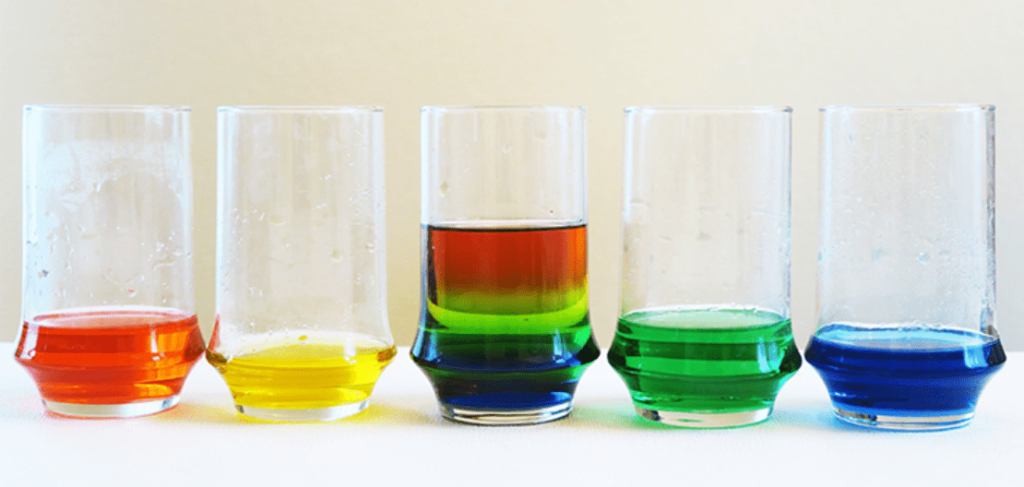
Overview:
This science experiment is especially meant for older kids, but it can me modified for kids of all ages. Your kids will love this colorful experience about density and buoyancy, and all you need are some common household ingredients.
What You Need:
food colorings (preferably in rainbow colors including red, orange, yellow, green, blue, purple)
water
a clear straw
sugar
6 cups
tablespoon
Steps:
First, fill each of the cups with the same amount of water.
Next, add the food coloring, one color in each cup, preferably in rainbow order.
Line the cups up next to each other.
In the first cup, do not add any sugar at all.
In the second cup, add one tablespoon of sugar.
In the third cup, add two tablespoon of sugar.
In the fourth cup, add three tablepoons of sugar, and so on.
Stir each mixture until all the sugar is dissolved in each glass.
The next step is to make a sugar rainbow by placing the end of the straw in the first cup (the cup with no sugar), only about a half of an inch.
Cover the top of the straw with your thumb before lifting it out of the water so that the water does not fall out of the straw.
Now dip the straw into the second cup (1 tablespoon sugar). This time, insert it deeper so that the end is one inch below the water level. In one quick move, release the thumb and recap again. Now you should have two layers of color.
Keep dipping the straw into each solution from the one with the least sugar to the one with five tablespoons of sugar. Each time, the straw is inserted half an inch deeper.
What's happening?
Density is the amount of substance (mass) within the volume occupied by the object. If two cups have the same amount of water (i.e. same volume), the one with more sugar is denser than the one with less sugar.
Buoyancy is determined by relative density. The solution with less density floats above the solution with higher density. That is why the color don't mix.
Sugary water has higher density than plain water. The solution with more sugar has higher density than the one with less sugar. If you have inserted the straw in the solutions from the least sugar to the most sugar, then the color don't mix and you have a sugar water rainbow.
19. Painted Nature
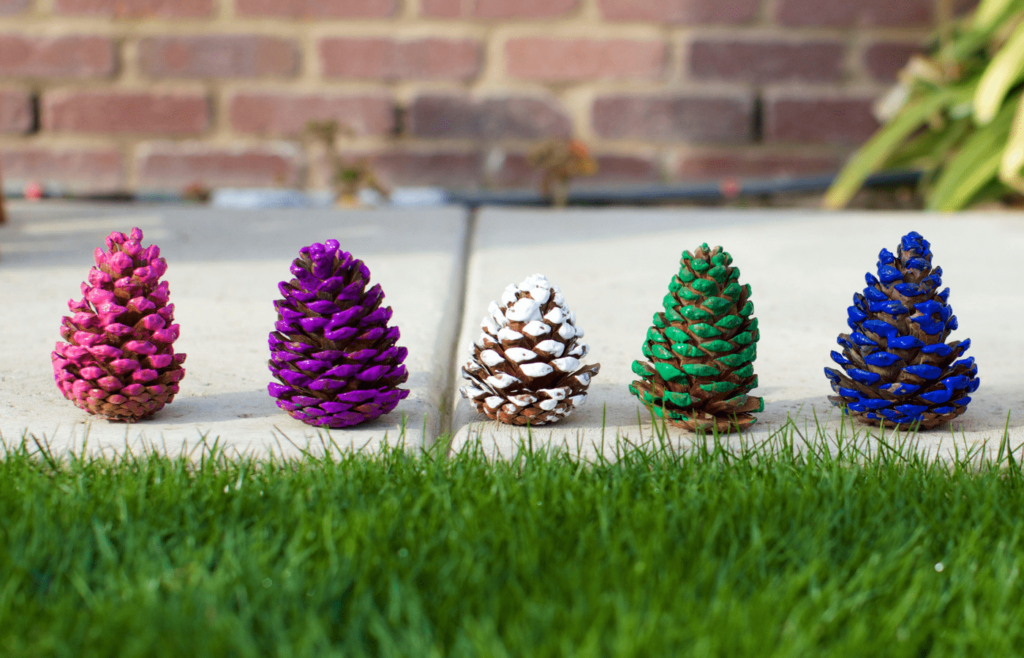
Overview:
In this activity, kids will be closely observing natural phenomena, looking for signs of life and growth, and using their senses to experience natural materials. These skills are extremely important scientific foundations.
Steps:
First, have your child search for natural objects in nature. Fill a bag with interesting sticks, leaves, rocks, twigs, pebbles, and anything else you can find.
Next, bring them into the "classroom" or home to closely observe and paint them.
As you paint, you can discuss the natural colors and features of these objects: What is their texture? What do they notice about each object?
20. Magnet Dump
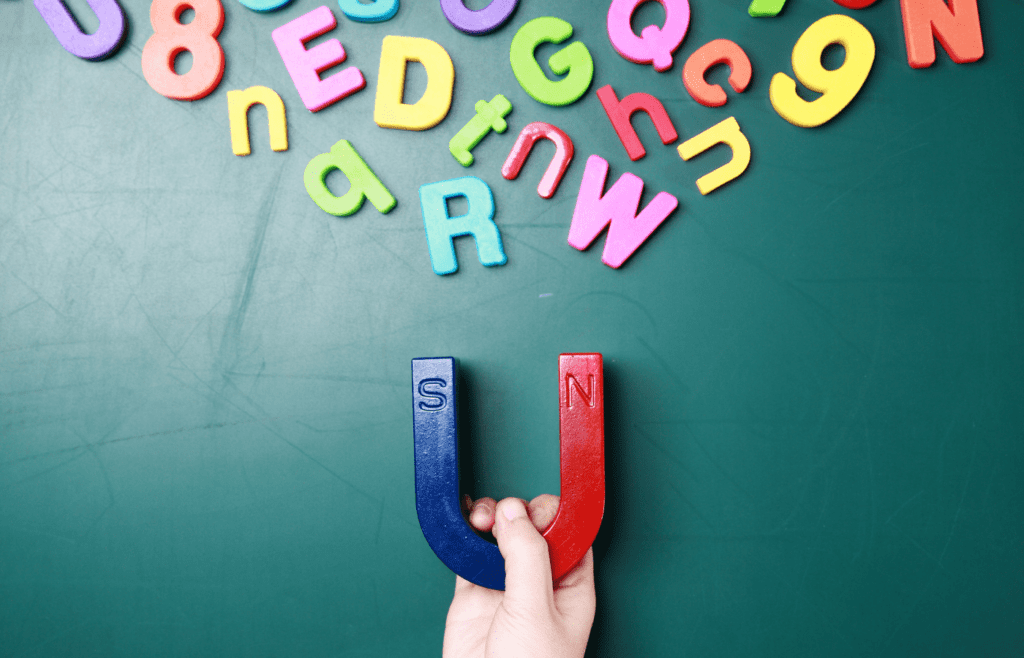
Overview:
This activity is a great introductory magnet activity, and for younger kids, they'll be practicing skills of classifying and sorting.
Steps:
First, dump out a selection of metal objects onto the table.
Next, ask your kids to help you "clean up" by using the magnets to pick up different objects and sort them into containers.
Discuss which objects are attracted to a magnet and which are not. What patterns do they notice? What other objects would they like to try?
21. Magnet Magic
Materials:
-Clear plastic box (look in your recycling bin)
-Pipe cleaners
-Scissors
-Magnet
This super-easy experiment is a really fun way to teach your child about magnets in a colorful, magical way, and it only requires simple materials from around the house.
First, cut up several pipe cleaners and place them in a clear plastic box. The box does not need to be fancy, just see-through.
For your first time through this demonstration, have your child take a magnet and touch it against the surface of the plastic box. They'll find that the pipe cleaners are lifted up and move with the magnet!
What's Happening?
Magnets attract certain types of metal. The pipe cleaners have a thin strip of metal, so the magnet is able to attract those pieces and pull it around the box.
Extension: Next time, think of what other objects could you place in the box? What objects do you predict the magnet could move around?
22. Will it melt?
Overview:
In this experiment, your kids will learn about heat and how it affects every day objects.
Steps:
First, gather a range of materials (within reason) and put them in a muffin tin.
Discuss with your kids about how temperatures can get high, especially on hot days.
Ask your kids to hypothesize about what will and won't melt.
Then put it to the test!
Caution! Be extremely careful about what you put in the muffin tin so that you do not start a fire or ruin your pan.
23. Traveling Rainbows
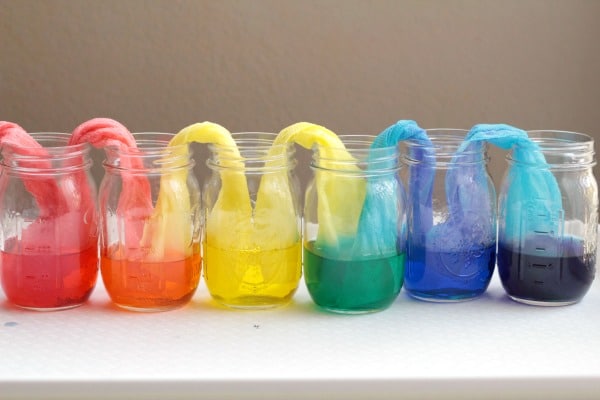
Overview:
This colorful experiement is a super simple way of demonstrating capillary action, water travel, and color mixing.
Kids of all ages will love watching the color move through the paper towel on its own, and they'll have a better idea of how plants get their nutrients.
What You need:
6 glasses or jars
Paper towels
Food coloring (red, yellow, & blue)
Steps:
First, fold six sheets of paper towel lengthwise. You may need to cut a few inches off so that it fits into the glasses well. They should go from the bottom of one mason jar to the next without sticking up too high in the air.
Next, fill the first glass with a generous squirt of red food coloring, the third with yellow, and the fifth with blue. Mix it up with a plastic spoon. Leave the other glasses empty.
Then, add water to the glasses with color until the colored water almost reaches the top.
Now add the paper towels. Starting with red, add once end of the paper towel and put the other end in the empty glass next to it.
After several minutes, the colored water will travel almost the whole length of each paper towel. You can watch the water do its magic for about 20 minutes!
What's Happening:
The colored water travels up the paper towel by a process called capillary action. Capillary action is the ability of a liquid to flow upward, against gravity, in narrow spaces. This is the same thing that helps water climb from a plant's roots to the leaves in the tree tops.
Paper towels (and all paper products) are made from fibers found in plants called cellulose. In this demonstration, the water flowed upwards through the tiny gaps between the cellulose fibers. The gaps in the towel acted like capillary tubes, pulling the water upwards.
The water is able to defy gravity as it travels upward due to the attractive forces between the water and the cellulose fibers. The water molecules tend to cling to the cellulose fibers in the paper towel. This is called adhesion. The water molecules are also attracted to each other and stick close together, a process called cohesion. So, as the water slowly moves up the tiny gaps in the paper towel fibers, the cohesive forces help to draw more water upwards.
24. LEGO Boats
Overview:
This experiements present a great opportunity to get kids thinking about engineering and design.
Steps:
First, challenge your kids to build their own boat out of LEGO bricks. For an added challenge, only give them a certain number of pieces.
Once everyone has finished building, put the boats to the test in a tub of water.
Add pennies a few at a time to see how many each boat can hold.
Talk to your kids about how weight and design matter. Reflect on good designs and help them understand why they worked well.
25. DIY Parachute
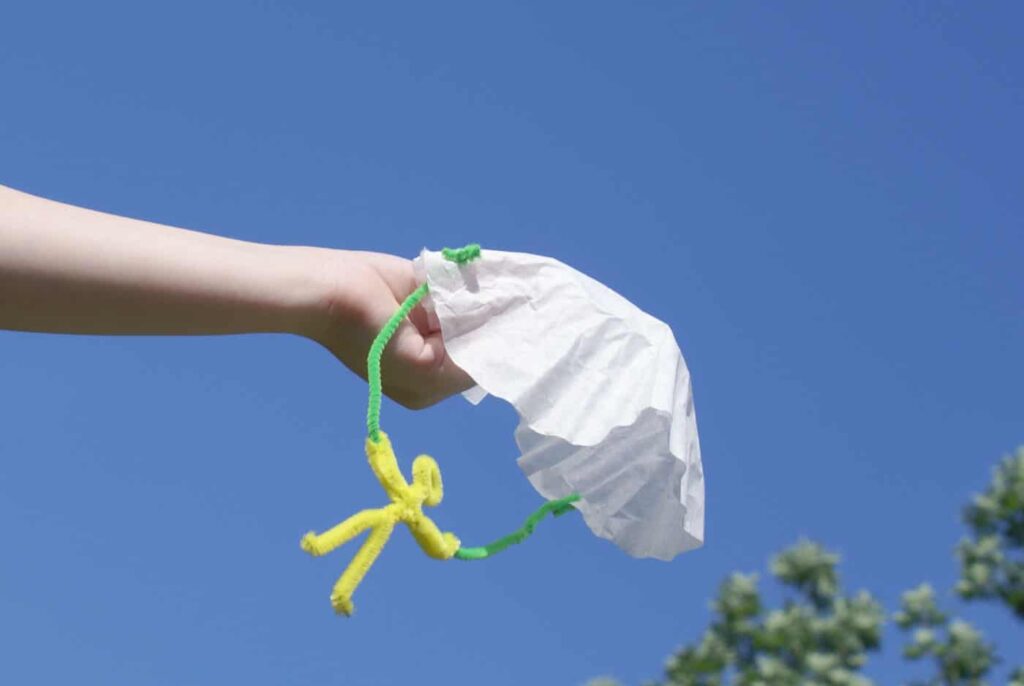
Overview:
You can learn about gravity by making a DIY parachute for a light-weight toy. The parachute is easily made from materials around your house, and you can experiment with different strategies and objects.
Materials:
Plastic Bag (i.e. grocery bag)
Yard/String
Paper Cup
Scissors
Steps:
First, use the scissors to remove the handles from the plastic bag. Next, poke four holes around the plastic bag so that they are the same distance apart and on opposite sides of the bags.
Then, cut four holes into the rim of the paper cut.
You'll also need to cut four pieces of yarn, 10-12 inches long. Thread one piece of yarn through the hole in the plastic cup and tie the yarn to the cup with a knot. Repeat with all four strands of yarn in the remaining holes.
Next, thread the other end of the pieces of yarn through the hole in the plastic bag and tie a knot.
Finally, personalize and decorate your cup with stickers, paint, crayons or markers.
Now it's time to find a toy that is going to take a ride in your parachute. Launch your parachute into the air and see what happens!
Experiment with putting different objects into the paper cup and see how it affects the parachute's effectiveness. Does the parachute flight time increase or decrease?
You can also try creating the parachute with different materials to replace the paper bag, such as a paper towel or napkin, and see how that affects the performance.
26. Magic Milk Experiment
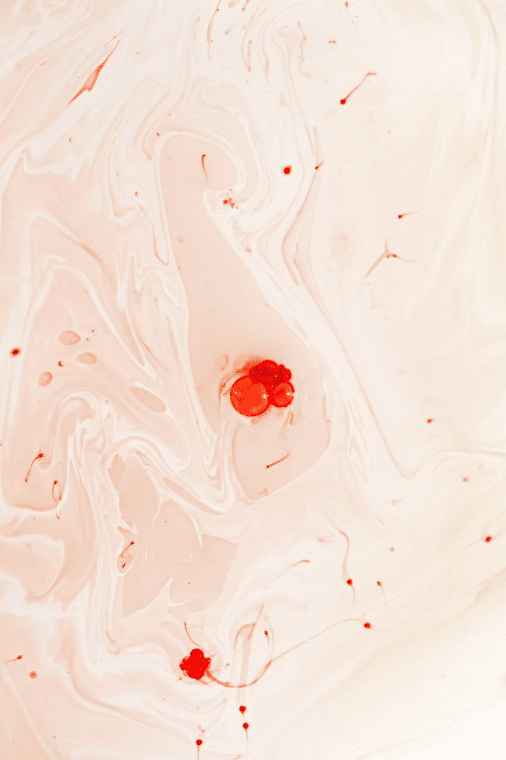
Materials:
-Full Fall Milk
-Food Coloring
-Dawn Dish Soap
-Cotton Swabs
Steps:
First, pour the milk in a small baking dish until the bottom is covered. Next, fill the milk with drops of food coloring. Glitter is optional!
Then, pour some dishwashing soap into a bowl, and dip your cotton swap tip into the dish soap to coat it. Then, gently touch your cotton swab to the milk and watch what happens!
Milk is composed of minerals, proteins, and fats, which are easy to change. When you add the dish soap to the milk, the soap molecules try to attach to the fat molecules in the milk.
When everything stops moving, you can see where all the fat molecules are.
27. Steel Wool & Vinegar Reaction
This experiment will make abstract concepts like "chemical reaction" and "rusting" become more clear and concrete.
Materials:
-steel wool
-vinegar
-two beakers
-something to cover the beaker (paper or a lid)
-Thermometer
Steps:
First, place the steel wool in a beaker. Then, pour vinegar onto the steel wool and let it soak for about a minute.
After a minute or so, take the steel wool out and shake off any excess vinegar.
Next, wrap the steel wool around the base of the thermometer and then place them both in the other beaker.
Then, cover the beaker with paper or a lid. It's important that you keep the heat in.
You'll want to make sure that you can still read the temperature on the thermometer. It's a great idea to poke a hole if possible through the covering so that the thermometer can fit through it, and you can easily read the temperature.
Make a note of the initial temperature, and observe it for about five minutes.
What's Happening?
You will see that the temperature on the thermometer gradually rises, and the beaker will likely get foggy. When you soaked the steel wool in vinegar, it removed the protective coating on the steel wool, allowing the iron in the steel to rust.
Rusting is actually a chemical reaction between iron and oxygen (or oxidation). This is the chemical reaction that creates heat, thereby increasing the temperature of the beaker and on the thermometer. This is an examples of an exothermic reaction (a chemical reaction that releases energy in the form of heat).
28. Invisible Ink

In this fun experiment, your kids can write secret messages that they will learn how to reveal scientifically. You need only basic materials, and it's sure to be a big hit.
Materials:
-Cotton swab
-lamp or light bulm
-plain white paper
-bowl or cup
-lemon juice
Steps:
First, squeeze the lemon juice into a bowl or cup and mix in a few drops of water.
Next, dip the cotton swap into the lemon juice / water mixture, and write a secret message or draw a secret picture onto the plain white paper.
Wait a few moments for the paper to dry and for the juice to become invisible.
Finally, hold the paper close to a light bulb or lamp and reveal your secret messages.
What's Happening?
Lemon juice contains carbon compounds that are colourless at room temperature. The heat source (in this case the light bulb) breaks down the compounds and thereby releases the carbon. The carbon oxidizes when it comes into contact with the air. It then turns brown, making your invisible message visible under the hot light bulb.
29. Corn Syrup Viscosity Experiment
Overview
This experiment could not be simpler, and it's the perfect tool for teaching kids of any age about viscosity.
Materials:
-Corn Syrup
-2 glass containers (one should be smaller than the other)
-cupcake pan or 3 small bowls
-Food coloring
-Dropper
Steps:
First, fill the larger glass container 1/2 to 3/4 full with corn syrup. Then, add the small glass container to the center. Careful! The corn syrup will rise a bit when you do this.
Next, Use a cupcake pan or 3 small bowls and put in a small amount of corn syrup. Mix each one with a food coloring of your choice. You should have three separate colors of corn syrup.
Then, put some colored corn syrup in the dropper, insert the dropper into the clear corn syrup and add the coloring in different places. Do that for each color as many times as you wish.
Now, you can turn the smaller glass jar while holding the outer glass still. The colored syrup will start to spread a bit. Now, switch direction and turn the small glass jar back to its original place. The colored dots return right back to their original form.
What's Happening?
Corn syrup has a viscosity that is 5,000 times that of water, so they don't mix in the same way.
30. Orange Fizz
Overview:
This sensory experiments is really fun for learning about acids and bases. And hardly any materials are needed!
Materials:
Orange or clementine
1/2 teaspoon baking soda
Steps:
First, separate the orange into sections. Then, dip a slice into the baking soda. Finally, take a bite. It will start to bubble in your mouth!
What's happening?
The citric acid from the orange and the opposite base from the baking soda are mixing together, creating carbon dioxide bubbles.
31. Dry Erase Magic
Overview: In this fun and easy experiements, you'll watch your very own drawing come to life and move around!
Materials:
Glass Plate
Dry Erase Marker
Water
Steps:
First, draw a picture on the plate with the dry erase marker. Try a stick figure to start!
Then, slowly pour water onto the plate. You'll see the drawing slowly lift up.
Finally, make your drawing move around by swirling around the water.
What's Happening?
The marker is a mixture of ink pigments and alcohol. When you pour the water on it, the alcohol dissolves, and the ink pigments become a solid that slides off the glass when it gets wet.
32. Homemade Play Dough
Overview:
This is a classic DIY project, and kids of all ages will love it.
Materials:
-3 cups of flour
-1.5 cups of salt
-6 teaspoons cream of tartar
-3 tablespoons of oil
-3 cups of water
33. Melting Snowballs
Overview:
This is another acid and base experiment, and it's fun on a couple different levels!
Materials:
-Baking Soda
-Water
-Vinegar
Steps:
First, form snowballs by adding water to the baking soda. You'll need about a 1/3 cup per snowball.
Then, place them in the freezer for 15 minutes.
Finally, pour drop of vinegar on the snowballs and watch them sizzle and melt.
Variations:
You can also make a snowman and do the same thing!
34. Exploding Soap
Overview:
This is a surefire hit, and all you need is soap and microwave!
Materials:
-Ivory Soap
-Microwave
Steps:
First, put the bar of soap in a microwave safe bowl. Then, heat it up on high power for two minutes. Enjoy the show as the soap grow! Finally wait a couple of minutes for the bowl and foam to cool before you touch it.
What's happening?
Ivory soap contains small air bubbles that expand when heated in the microwave. The soap is in a solid state, so when it expands, it stays in its expanded size for the most part.
35. Paper Airplanes
Overview: There's no better way for kids to learn about aerodynamics than by making a paper airplane. Head to this epic website for dozens of designs!
36. Flying Ping Pong
Overview:
Your kids will love this flying ping pong trick, and there are only two things you need.
Materials:
Ping Pong
Hair Dryer
Steps:
First, make sure your hair dryer is on a cool setting.Then, hold the ping pong above the nozzle and turn on the air. When you let the ping pong go, it should float! Next, try it on different settings. Try to see how far you can tilt your hair dryer before the ball drops.
37. Magical Balloon
Overview:
Your kids won't believe their eyes when you push a needle through a balloon and it doesn't pop!
Materials:
-A balloon
-A needle
-Scotch tape
Steps:
First, blow up your balloon. Next, take two pieces of scotch tape and make an X on your balloon. Then, with parental supervision, push a needle through the middle of your X.
Leave the needle in and see how long it take for your balloon to finally pop!
What's happening?
The tape slows down the process of the hole in the balloon widening, so it takes longer for the balloon to pop.
38. Wacky Spoon
Overview:
This is more of a science trick than an experiment, but it's super easy to do at home!
Materials:
Kitchen Spoon
Steps:
Look at your reflection in a large spoon. It will be upside down!
What's Happening:
A regular mirror is flat and sends your reflection straight back into your eyes. The rounded spoon bounces your reflection back at different angles and turns your reflection upside down.
39. Floating Eggs
Overview:
This experiment will show your child how things float differently in fresh water and salt water.
Materials:
-2 Egg
-Salt
-Water
-2 tall drinking glasses
Steps:
First, fill one glass with water. Then, fill another glass with water and add 8 tablespoons of salt. Mix it up.
Next, place an egg in both glasses. One will float and the other will sink.
What's happening?
Adding salt to the water increases the water's density which causes the egg to float.
40. Jumping Pepper
Overview:
This simple experiment will demonstrate static electricity right before your eyes.
Materials:
-Plate
-Salt
-Pepper
-Hair Comb
Steps:
Place a tablespoon of pepper on a plate. Then, run a hair comb through your hair. While still holding on the comb, hold the comb over the plate and watch the pepper jump!
What's happening?
The plastic comb builds up a negative charge as it moves through you hair. The pepper has a positive charge, so it jumps!
Variations:
Try it with other spices and powders.
41. Walking on Eggs
Overview:
Your kids will be astonished to see that they can actually walk on eggs without breaking them!
Materials:
-6 dozen eggs in their cartons
-Drop cloth / newspaper
Steps:
Lay down your drop cloth in case the experiment doesn't work as expected!
Place the open egg cartons next to each other. Tkae off your sock and shoes and gently step onto the eggs keeping your feet flat. Then bring up your other foot and carefully walk across the eggs.
What's Happening?
Your foot is big enough that your weight spreads evenly out across the eggs, keeping them from breaking.
Variation:
You can also demonstrate this concept with a heavy book.
42. Disappearing Reflection
Overview:
Make your reflection vanish! All you need is aluminum foil.
Materials:
-Aluminum Foil
-Scissors (optional)
Steps:
Rip off a large piece of aluminum foil (ten inches should do) and take a look at your reflection. Then, crumple up the aluminum foil. Next, Carefully flatten it back out. Finally, look for your reflection. It's nowhere to be found!
What's happening?
When the aluminum foil is smooth, light reflect off of in in straight lines, which enables you to see your reflection. But once you crumple the foil, it has a wrinkled surface that sends your reflection in all different direction, causing it to disappear.
43. Defy Gravity!
Overview:
When you turn over a cup of water, you expect the water to spill and fall. But not always!
Materials:
Clear plastic cup
Water
Playing card or notecard
Steps:
First, fill your clear glass about 3/4 of the way with water.
Next press your playing card or notecard gently on the top of your glass to completely cover the top. Gently rotate the cup upside down. After a few moments, remove the card. The water will stay in place!
Variation:
Try it again, adding something that will float in the water. Repeat the steps, and see what happens!
44. Skittle Heart
Overview: Especially around Valentine's Day, this science experiment will be well loved by your kids.
Materials:
Small bowl with a flat surface. (Like a small pie pan.)
Skittles
Heart-shaped cookie cutter (or any shape)
Steps:
Place your skittles around the outside of the bowl in an intentional pattern. Two red skittles, following by two purple skittles, etc works well. Then, place the heart cookie cutter in the center of the bowl. Slowly pour water into the cookie cutter and see how the colors from the skittles magically fill the bowl!
45. Water Fireworks
Overview:
This totally safe fireworks experiment will be a hit around the Fourth of July or any time!
Materials:
Tall water glass
Small water glass
Oil
Food coloring
Fork
Steps:
First, fill up your all water glass almost all the way with water. In the small glass, pour two tablespoons of oil. Add 2 drops of food coloring to it and mix it around with a fork until the food coloring is broken up into smaller specks.
Then, pour the oil mixture into the water and see the firework expand!
What's happening:
Food coloring dissolves in water but not oil, causing it to go different directions.
Variations:
Try two colors! Try a different size glass!
46. Bird Feeder Fun
Overview:
In this simple science project, you'll learn where birds like to have their meals.
Materials:
-Pipe Cleaner
-Cheerios
Steps:
Place cheerios on a pipe clean and make a simple circle. Place it out for the birds to eat.
To experiment, place different bird feeders in different places and see if it makes a difference for how much gets eaten.
You could also make your bird feeder into different shapes to see how the birds prefer it.
47. Rain Gauge
Overview:
It's super simple to make a rain gauge from a soda bottle and track your are'a rain water!
Materials:
Soda Bottle
X-acto knife (with parental supervision)
Steps:
Cut the top off of a soda bottle and invert the top so that the rain water funnels into the bottle. You may want to secure it with duct tape. Next, place it outside in a spot where it can collect rain water.You'll want to secure it so it doesn't fall over. Then, begin measuring the rain water each day!
48. Magic Leak Proof Bag
Materials:
-Ziplock Back
-Water
-Very Sharp Pencils
Steps:
Fill your bag up halfway with water. Carefully poke the pencil through the bag and out the other side. (Don't push the pencil all the way through so that it comes out the other side!)
What's happening?
The plastic bag's molecules form easily around the smooth sides of the pencil forming a seal.
49. Paper Cup Tower
Overview:
Similar to the "walking on Egg" experiment listsed above, this activity will wow your children as they discover they won't crush the paper cups by standing on them!
Materials:
8 paper cups
Cardboard
Steps:
First, set the paper cups on the grounds, spaced evenly. Next, place the cardboard on top of them. Then, try to stand on it and see what happens. Can you make another level?
50. Rubber Band Guitar
Overview:
Tap into your musical side and explore sound with this simple rubber band guitar.
Materials:
Paper or plastic cup
Rubber bands
Steps:
First, wrap your rubber bands of different sizes around the cup so that the rubber bands act as strings over the hole of the cup. Then, pinch the sides of them together as best you can and tap them around the sides of the cup. See what sounds they make, and experiments with rubber bands of various sizes to see what sounds they make!
More Science Experiments We Love:
51. Rock Candy Experiment – Grow colorful rock candy in a glass!
51. Giant Dish Soap Bubbles – Make a giant bubble with household ingredients.
52. Solar Oven S'mores – Cook up a tasty snack in a solar oven.
53. Layering Liquids – See how liquids can stack on top of each other according to density.
54. Human Sundial – Become a human sundial to learn about solar patterns.
55. Windowsill Trash – Demonstrate how the heat of the sun helps trash decompose.
56. Naked Egg Experiment – Dissolve an eggshell with vinegar and see the membrane below!
57. Balloon Magic – Blow up a balloon without blowing, using vinegar and baking soda.
58. Tornado in a Bottle – Create a cyclone in a bottle in this classic, simple experiment.
59. Egg Teeth – Explore how sugar affects teeth in this easy experiment.
60. Step Through an Index Card – Amaze your kids by stepping through an index card that's been strategically cut.
61. Frozen Bubbles – Find out what happens when you blow bubbles in freezing temperatures.
66. Make Butter – Shake cream and turn it into butter!
67. Ice Cream in a Bag – Turn simple ingredients into delicious ice cream.
68. Moldy Break Experiment – See how important it is to wash your hands in the viral science experiment.
69. Map Your Taste Buds – Learn about your taste buds in this easy mapping activity.
70. Make a Rainbow – See how you can easily create your own rainbow.
71. Soap Boats – Explore density with this easy DIY boat-making activity.
72. Egg Drop Project – See if you can build a contraction to protect an egg from breaking.
73. Growing Gummy Bears – Watch gummy bears grow before your eyes.
74. Fingerprinting – Dive into the infinite world of fingerprints with a no. 2 pencil and paper.
75. Homemade Bouncy Balls – Make your own bouncy ball toys with household ingredients.
We hope you loved this list of our very favorite science experiments!
Email us at hello@mkewithkids.com to add your idea.
MORE POPULAR POSTS:
25 Best Games To Play Over FaceTime With Friends
25 Classic Children's Books To Read With Your Kids
20 BEST Water Balloon Games For Kids
25 Best Big Sister Gift Ideas for 2 Year Olds & Up
31 Best Educational Websites You Didn't Know About
5 Ways To Play Hopscotch + Fun Variations (2021)
25 Simple Shape Activities for Preschoolers
burgesstragstenk1950.blogspot.com
Source: https://www.mkewithkids.com/post/here-are-two-weeks-worth-of-fun-and-easy-science-experiments/